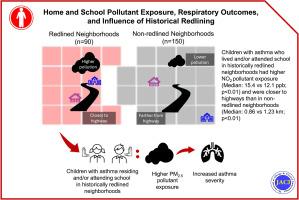Home and school pollutant exposure, respiratory outcomes, and influence of historical redlining
IF 11.4
1区 医学
Q1 ALLERGY
引用次数: 0
Abstract
Background
The discriminatory and racist policy of historical redlining in the United States during the 1930s played a role in perpetuating contemporary environmental health disparities.
Objective
Our objectives were to determine associations between home and school pollutant exposure (fine particulate matter [PM2.5], NO2) and respiratory outcomes (Composite Asthma Severity Index, lung function) among school-aged children with asthma and examine whether associations differed between children who resided and/or attended school in historically redlined compared to non-redlined neighborhoods.
Methods
Children ages 6 to 17 with moderate-to-severe asthma (N = 240) from 9 US cities were included. Combined home and school exposure to PM2.5 and NO2 was calculated based on geospatially assessed monthly averaged outdoor pollutant concentrations. Repeated measures of Composite Asthma Severity Index and lung function were collected.
Results
Overall, 37.5% of children resided and/or attended schools in historically redlined neighborhoods. Children in historically redlined neighborhoods had greater exposure to NO2 (median: 15.4 vs 12.1 parts per billion) and closer distance to a highway (median: 0.86 vs 1.23 km), compared to those in non-redlined neighborhoods (P < .01). Overall, PM2.5 was not associated with asthma severity or lung function. However, among children in redlined neighborhoods, higher PM2.5 was associated with worse asthma severity (P < .005). No association was observed between pollutants and lung function or asthma severity among children in non-redlined neighborhoods (P > .005).
Conclusions
Our findings highlight the significance of historical redlining and current environmental health disparities among school-aged children with asthma, specifically, the environmental injustice of PM2.5 exposure and its associations with respiratory health.

家庭和学校的污染物暴露、呼吸系统结果以及历史上重新排序的影响。
背景:20 世纪 30 年代,美国历史上的歧视性种族主义政策--红线政策--在延续当代环境健康差异方面发挥了作用:我们的目标是确定患有哮喘的学龄儿童的家庭和学校污染物暴露(细颗粒物(PM2.5)、二氧化氮(NO2))与呼吸系统结果(哮喘严重程度综合指数(CASI)、肺功能)之间的关联,并研究居住和/或上学于历史上被划为红线的社区的儿童与未被划为红线的社区的儿童之间的关联是否存在差异:方法:研究对象包括美国 9 个城市中患有中度至重度哮喘的 6 至 17 岁儿童(N=240)。根据地理空间评估的月平均室外污染物浓度,计算家庭和学校的 PM2.5 和 NO2 暴露量。收集了 CASI 和肺功能的重复测量数据:总体而言,37.5%的儿童居住和/或就读于历史上被划为红线的社区。与非红线社区的儿童相比,红线社区的儿童暴露于二氧化氮的程度更高(中位数:15.4 ppb 对 12.1 ppb),与高速公路的距离更近(中位数:0.86 km 对 1.23 km)(p2.5 与哮喘严重程度或肺功能无关)。然而,在红线社区的儿童中,PM2.5越高,哮喘严重程度越严重(P0.005):我们的研究结果凸显了历史上的红线区和当前环境对哮喘学龄儿童健康的影响,特别是 PM2.5 暴露的环境不公正性及其与呼吸系统健康的关系。
本文章由计算机程序翻译,如有差异,请以英文原文为准。
求助全文
约1分钟内获得全文
求助全文
来源期刊
CiteScore
25.90
自引率
7.70%
发文量
1302
审稿时长
38 days
期刊介绍:
The Journal of Allergy and Clinical Immunology is a prestigious publication that features groundbreaking research in the fields of Allergy, Asthma, and Immunology. This influential journal publishes high-impact research papers that explore various topics, including asthma, food allergy, allergic rhinitis, atopic dermatitis, primary immune deficiencies, occupational and environmental allergy, and other allergic and immunologic diseases. The articles not only report on clinical trials and mechanistic studies but also provide insights into novel therapies, underlying mechanisms, and important discoveries that contribute to our understanding of these diseases. By sharing this valuable information, the journal aims to enhance the diagnosis and management of patients in the future.

 求助内容:
求助内容: 应助结果提醒方式:
应助结果提醒方式:


